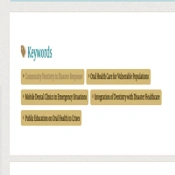Dear Editor,
Natural disasters such as earthquakes, floods, and hurricanes have devastating consequences on communities, affecting their well-being and access to essential health services (1). While the immediate response often focuses on emergency medical care and infrastructure recovery, oral health is frequently neglected despite its critical role in overall health (2). Neglecting dental care in disaster-affected populations can lead to worsening infections, increased pain, and long-term health complications (3).
The concept of community dentistry in disaster response revolves around providing accessible, preventive, and emergency oral health care to underserved populations during crises (4). Dental health professionals contribute significantly to alleviating pain, treating infections, and ensuring proper oral hygiene education in disaster-stricken areas (5).
Past disaster relief efforts have demonstrated the importance of integrating oral health services into emergency response strategies. In the aftermath of the 2010 earthquake in Haiti, dental teams were deployed to provide emergency extractions, infection treatment, and pain relief for affected individuals (6). They also conducted public health education on maintaining oral hygiene under difficult conditions. Similarly, following the 2004 Southeast Asia tsunami, mobile dental clinics were set up in temporary shelters and rural areas, ensuring continued access to basic dental care for displaced populations (7). In the United States, after Hurricane Katrina (2005), community dentistry efforts were instrumental in assisting evacuees by setting up emergency dental clinics in shelters and relief centers to address urgent oral health issues (1).
From these experiences, key lessons emerge to enhance the role of community dentistry in future disaster responses:
- Incorporating dental professionals into disaster preparedness plans at local and international levels ensures rapid deployment and efficient intervention (4).
- Providing mobile dental clinics in high-risk zones improves accessibility and reduces long-term oral health complications (3).
- Ensuring the availability of emergency dental supplies and medications allows immediate pain relief and infection management (5).
- Educating affected communities on basic oral hygiene practices reduces the incidence of preventable dental conditions during crises (8).
Given the specialized nature of community dentistry in disaster contexts, the availability of structured policies and targeted interventions is vital. Future strategies should focus on strengthening interprofessional collaboration, investing in mobile health solutions, and expanding the reach of emergency oral care services. By prioritizing oral health in disaster recovery frameworks, healthcare systems can better support affected populations, improve long-term health outcomes, and create more resilient communities in the face of future disasters.
